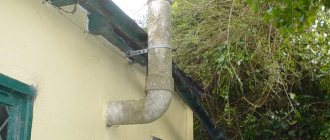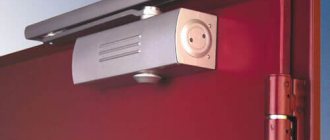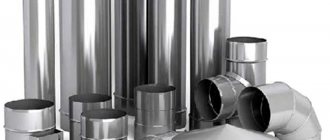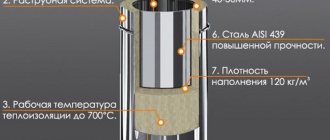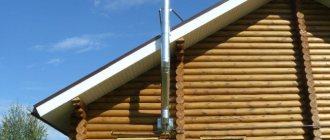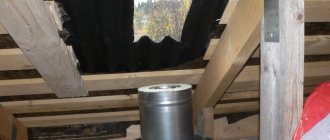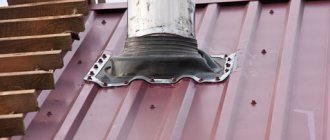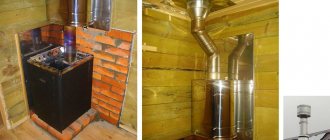Here you will learn:
- Calculation of chimney parameters
- Types and designs of steel chimneys
- Advantages of a steel chimney pipe
- Advantages and disadvantages of sandwich chimneys
- Installation recommendations
- Installation of a sandwich system for smoke removal
- Maintenance of the assembled system
The installation of heating devices is subject to the requirements set out in the regulatory documentation.
Installation of devices is regulated by the provisions of SNiP 2.04.05–91 and DBN V.2.5-20-2001. Also, before drawing up a project, it is advisable to study materials on heating systems (SNiP 41-01-2003), on heat generation devices (NPB 252–98), on technical conditions for the operation of heating devices (GOST 9817–95), on the rules and regulations for the operation of smoke ducts (VDPO).
The design of the chimney and installation features must fully comply with the requirements specified in SNiP, otherwise you will not receive a construction inspection certificate, which is issued after commissioning
Some of the requirements are addressed specifically to the installation of chimneys. The design of the structure can be anything, but the material must be non-flammable.
The materials used for the construction of chimneys can be:
- steel;
- ceramics;
- brick.
Without exception, all structures are prefabricated, and the installation itself is fragmentary, since the chimney passes through several rooms (for example, a room and an attic).
In order for a structure to meet fire safety requirements, its parameters must be correctly calculated, and all component parts must be sized accordingly. When installing factory equipment, you must follow all the recommendations set out in the instructions, including the assembly procedure and methods for installing parts.
A brick pipe is a classic option for a solid fuel system, in which the flue gas temperature reaches 500-700º. Laying it is a labor-intensive process, but if you follow the rules, it can be done with your own hands
A chimney with characteristics as close as possible to a brick pipe can be made from modules of a ceramic chimney system
The construction of a metal chimney from ready-made pipes is simpler and faster than all types of chimneys currently used. However, in solid fuel systems they try not to use this option, because metal pipes burn out quickly and require frequent replacement
One of the modernized variations of a metal pipe is the sandwich chimney. Due to its special design, its service life is increased and its technical performance is improved. Brick pipe of a solid fuel system.
The documentation contains certain provisions that also need to be taken into account, for example:
- the length of the chimney can be any, but not less than 5 m (the height of the ventilation ducts is not less);
- the cross-section of the pipe must correspond to or exceed the inlet hole in the generator;
- each heat generator requires a separate chimney;
- the speed of flowing air inside the pipe is from 15 m/s to 20 m/s;
- the thickness of the pipes is determined by the material of manufacture (the norm for steel is at least 0.5 mm);
- for regular inspection and cleaning activities, chimneys are equipped with pockets (niches) 0.25 m deep;
- the maximum number of chimney turns is 3;
- the radius of curvature must exceed the diameter of the channel;
- the height of the pipe above the roof is regulated by the roof structure: on a flat one – 0.5 m; 0.5 higher than the roof if it is located at a distance of 1.5 m (or less) from the ridge; equal to or greater than the ridge axis if located at a distance of 1.5-3 m.
The order of construction of the structure has been established - always from the bottom up, that is, from the heat generator (boiler, furnace) through the floors to the roof. In prefabricated structures, each subsequent pipe part is inserted into the previous one.
The operating temperature of sealants used to fix parts must be at least 1000º. The connections are equipped with clamps on the outside; fastening material should not get inside the chimney.
Support brackets are provided for fastening the tee, and in order to avoid sagging of the channel, clamps must be fixed to the wall every 2 m to support the pipe
The regulatory documentation defines the places where chimneys are allowed to be installed. The wall material must be non-flammable, but if this condition is not met (for example, in a building with wooden walls), then during installation, for protection purposes, cap or crown pipes should be used.
How should a chimney be installed?
The chimney is an integral part of the heating system and its placement directly depends on the location of the heating device. The best location for the chimney system is inside the building. In such conditions, the chimney is protected from cold air, and the draft is not affected by wind surges, which makes it stable and optimal. It is best to bring the pipe outside under the very ridge of the roof in order to minimize atmospheric influences on the DS.
In the case when the heating operates constantly, for example, a gas boiler, then there is not much difference where the chimney will be placed - indoors or on the facade. And if the heating is not constant, for example, a stove or fireplace, then problems may arise with their operation. The fact is that the chimney does not generate heat and cannot heat itself. This function is assigned to the heating device. The chimney only needs to reliably and safely remove the flue gases that are formed due to the combustion of fuel to the outside.
Let's imagine a situation: the heating device is not functioning, and the chimney runs along the facade of the building. In this case, heated flue gases stop flowing into the smoke channel; they cool and freeze. And no matter what measures are taken to insulate the chimney (shaft equipment, increasing the thermal insulation layer), the temperature inside the chimney will be almost identical to the outside one.
Let's look at a simple example. Imagine a house under construction that already has walls and a roof, windows and doors installed, but no heating. So, no matter how thick and insulated the walls of the building are, the temperature in the room will be the same as outside.
Calculation of basic parameters
When making calculations, you need to take into account the individual characteristics of your home or building. Arranging your chimney involves certain rules. For example, for each type of channel, its own calculation principle can be applied, depending on the heating source used. This is one of the most important points and must be taken into account.
Chimney diagram
When installing a chimney, the main thing here is that the word is correct, the channel must be reliable and comply with standards. To do this, you can use the correspondence table or compare the characteristics of the house and communications yourself, especially since there are specialized services that can calculate the main indicators for you. The “machine” will do the job more efficiently, there will be no mistakes, therefore, when it comes to independently developing a circuit, think about the feasibility, especially if you did not have any skills in this matter before.
To calculate, you need to use the following indicators:
- Height.
- Length.
- Number of turns.
- Number of joints.
- Availability of hatches.
- Roof type, slope level, presence of ridge.
Height
The installation rules imply some features. The pipe must be optimal for reliable and high-quality removal of gases. However, be aware of safety concerns when removing, especially when it comes to flammable roofing materials. Remember an important point: the minimum permissible height above the roof is 50 cm. Such indicators should be used for flat buildings. If the design is more complex, additional calculations will be required, but for a clear understanding, we will give an example - if the ridge is from 1.5 to 3 meters, in this case, the head should rise at the same level as the ridge. If the distance is less than 1.5 meters, the pipe rises by at least 50 cm. In addition, remember that in cases where flammable roofing material was used, the pipe rise must be at least 1.5 meters. The total height must be more than 5 meters.
Calculation of chimney height
Section dimensions
To calculate the diameter, you need to proceed from the type and power of the equipment. What does the section consist of? For boilers and furnaces with a power of less than 3.5 kW, the diameter is calculated to be no less than 80 mm. Up to 5.2 kW, diameter is at least 95 mm. If the power exceeds 5.2 kW, then the diameter cannot be less than 110 mm.
The danger of a cold chimney
An air lock often forms in a cold chimney - this is a layer of cold air located inside the channel. It is because of this plug that the flue gases cannot escape. As a result, the gases will flow back into the room, and the heating device will not turn on or simply will not melt.
Ilya ManaevTechnical specialist at Schiedel
It is important to know! If, when lighting a fireplace/stove, smoke comes into the room or the gas boiler does not turn on, then it means that the heating device does not have enough draft. This usually happens when the chimney is cold. To correct the situation, you need to warm up the smoke channel. Crumple up some paper and burn it in the firebox or chimney. Due to this, the internal channel of the chimney will warm up and the necessary draft will appear.
Another disadvantage of a cold chimney is the unstable operation of the heating-chimney connection. Thrust changes may occur, which will lead to significant excess fuel consumption. And also, a chimney running along the facade will produce more condensation than a pipe located indoors.
Video description
What you need to know when choosing a sandwich chimney in the following video:
Ceramic chimney
For stainless steel chimneys, an important factor for flawless operation is high-quality thermal insulation between the sandwich layers. If a stainless steel pipe does not suit you, you can consider an alternative - a ceramic chimney with the following advantages:
- Ceramics is a material that has increased strength and is insensitive to intense heat (up to 1000°C).
Construction of a ceramic pipe Source stroiremdoma.ru
- Energy efficiency . Ceramics accumulate heat well and release it slowly. This property is especially valuable in a bathhouse, but it will also be useful in a residential building, where it will allow you to warm up, for example, an attic.
- Versatility . A ceramic pipe is connected to any stoves, fireplaces or boilers, regardless of the type of fuel.
- Durability . Ceramics are not afraid of temperature changes and chemical corrosion; soot is almost not retained on smooth internal surfaces (which also means high fire safety). Maintenance of such pipes will be minimal.
The downside is the high cost - such a design can hardly be called budget; Besides this, there are other disadvantages:
- Complex (sometimes poorly thought out) installation ; some manufacturers do not guarantee reliable operation.
Installation of ceramic pipes Source sckovcheg.ru
Attachment option
This type of connection of the chimney to the OP is conventionally called an economical option, since the installation of the entire system requires less fasteners when compared with other types of connections. Here the pipe stands and rests directly on the heating device. The connection is simple, but has serious drawbacks. In the mounted version, flue gases are removed by direct flow from the furnace. Because of this, excessive draft is created, which makes the fuel combustion process uneven and also increases its consumption.
Top-mounted chimney connection option
The next problem with a top-mount connection is condensate drainage. During the operation of heating devices, condensate forms, which must be removed from the firebox. Otherwise, condensation or moisture from atmospheric precipitation will fall directly into the firebox, which will lead to a reduction in its service life or destruction. And while a windproof umbrella will protect you from precipitation, there is practically no protection from moisture condensing in the channel.
Another disadvantage of a push-on connection is that it makes cleaning the chimney system more difficult. In this case, to clean the chimney, you need to dismantle the lower elements and securely fasten the upper part of the pipe. Another option is to remove soot from the firebox, if, of course, such a function is provided in the heating device. All this leads to an increase in the cost of cleaning and maintaining the diesel engine.
Advantages of a steel chimney pipe
Chimney pipes are made of metal, ceramics and brick. Metal pipes are currently in greatest demand. Of all the varieties of this material, it is recommended to choose steel. Steel pipes for chimneys are coated with special solutions that make the material resistant to all adverse effects of the internal environment of the chimney.
When choosing a pipe, it is necessary to take into account the parameters of the heating devices and the fuel used. The material from which the pipes are made must withstand higher temperatures than the fuel can create.
When using some types of heating devices, chemically active substances are found among the under-oxidized combustion products. They can damage a chimney that is not sufficiently resistant to chemicals. Some unburned particles can ignite, creating sparks. Therefore, the material from which the pipe is made must be fireproof.
This is interesting! When choosing a pipe, you need to pay attention to the melting point of the material from which it is made. The melting point of steel exceeds 1000 0C - the highest possible indicator encountered when operating heating appliances powered by coal.
The advantages of steel pipes are:
- Easy to install. Steel pipes do not require the installation of a special foundation; they do not require complex engineering solutions or special installation tools. You can install them yourself without prior preparation. Due to the plasticity of the material, complex technical structures can be created.
- Light weight. They are easy to transport, you can lift and move them yourself without a team of workers, which also simplifies installation.
- High temperature resistance. Steel products are suitable for appliances operating on any fuel. They do not melt at maximum temperature loads.
- Chemical inertness. Steel does not interact with chemical reagents that can form as under-oxidized combustion products. These substances are not capable of destroying it.
- Corrosion resistance. This advantage applies to pipes that have a special coating and stainless steel. The material itself quickly corrodes. It is worth considering that in addition to the internal environment, the chimney pipe is affected by external unfavorable factors, for example, precipitation. Preference should be given to coated pipes.
- Smooth inner walls. Combustion products settle on the rough surface, turning into soot, which gradually reduces the clearance. This reduces the draft in the chimney. Steel is completely smooth, the risk of soot settling on their surface is minimal.
We recommend reading: Why heating pipes in an apartment make noise or hum, and how to fix it
Wall and floor options
These types of connections are similar, except that the weight of the chimney is supported not by the heating device itself, but by fastening elements (console) located on the wall - this is a wall-mounted option. In the floor-standing version, the chimney stands on the floor.
Wall and floor-mounted chimney connection options
This connection option has significant advantages and also simplifies the operation of the chimney system and heating device:
Advantages of wall connection
Briefly about the main thing
A high-quality chimney for a bathhouse is a significant contribution to the comfort and safety of your holiday. When choosing a chimney system, they are guided by the size of the bathhouse and the power of the stove; this helps determine its working diameter and configuration.
Brick, asbestos cement, ceramics and various types of metal are used as materials for the construction of a chimney. Stainless steel construction is most often used as it has the most attractive combination of properties. The use of ceramic systems, as they are the most durable, looks promising. The Schiedel company manufactures and sells steel and ceramic chimneys in full factory readiness. Thanks to the use of modern technologies, all of them are designed for long-term stable operation, taking into account the safety and quality requirements of modern housing construction.
Additionally,
the exhibition of houses “Low-Rise Country” expresses its sincere gratitude to the specialists for their assistance in creating the material.Schiedel is an expert in smoke extraction - a manufacturer and supplier of chimney, stove and ventilation solutions.
For more information, visit schiedel.com
Ratings 0
Read later
Advantages and disadvantages of installing a steel chimney along the facade and indoors
The answer to the question why most people choose a steel chimney is simple:
Let's move on to the pros and cons of installing a chimney system outside and inside the building.
Ilya Manaev
Helpful information! Steel chimney systems are assembled without the use of sealants. All elements have socket connections. The DS parts are inserted into one another and crimped with a clamp. This guarantees tightness and high reliability of the system. Sealing compounds can only be used to connect the chimney and the heating device.
Advantages of installing a chimney on the facade:
- saving space indoors;
- DS cleaning takes place outdoors (no moisture or dirt);
- it is easier to install the chimney to the facade;
- there is no need to violate the integrity of the roof and ceilings.
Disadvantages of a chimney on the facade:
- if the heating device operates irregularly, an air lock may form in the internal chimney channel;
- a pipe running along the facade can reduce the aesthetic component of the building;
- Ice may form if proper condensate drainage is not organized;
- Single-wall chimneys cannot be used; only double-walled insulated steel chimneys are recommended.
Advantages of installing a chimney inside a building:
- optimal traction is created;
- the service life of the chimney is extended when compared with outdoor placement;
- no negative impact of wind loads and precipitation;
- the risk of damage to the chimney by third-party factors is minimized.
Disadvantages of a chimney indoors:
- during installation it is necessary to violate the integrity of the roof and ceilings;
- when the chimney is located in residential premises, cleaning and drainage of condensate is difficult;
- it is difficult to fix the DS to the mounting surface;
- the chimney may not fit into the design of the room.
Conditions for normal operation
The design should:
- effectively remove gaseous waste from fuel combustion;
- be safe and comfortable for home;
- have good traction;
- withstand high temperatures;
- be protected from moisture and condensation;
- be resistant to external aggressive environments.
Chimneys can have a square or cylindrical shape, the latter is considered optimal, since it is less susceptible to the accumulation of soot and soot.
Other parameters that are also indicated by building codes:
- alloy steel parts made for the installation of chimneys are distinguished by anti-corrosion qualities and have a thickness of 0.5 cm;
- the diameter of the pipe should be the same size as the furnace pipe or be slightly larger;
- a chimney arranged for a brick stove is equipped with pockets, which are located in the lower part of the chimney channels and have a depth of 20-25 centimeters. Doors are installed on them, through which soot deposits are removed;
- a metal chimney cannot have more than 3 turns;
- the turning radius of a metal chimney cannot be greater than the diameter of the pipe;
- the pipe must have a height of at least five meters.
All these conditions will help create normal draft in the chimney and effective removal of combustion products hazardous to health.
What to look for when installing steel chimney systems
Holes in ceilings, walls and roofs
When the installation parameters of the DS are determined (height, location, type of connection), you need to make holes in the ceiling, wall and roof. When making holes, it is necessary to take into account that the chimney will heat up during operation and this can lead to burns or fire. In this regard, it is necessary to strictly observe the clearances from combustible structures.
Ilya Manaev
It is important to know! Even if the chimney pipe passes through non-combustible structures, small gaps must be left, since the chimney system is a self-supporting independent structure. Its rigid fastening (clamping) to building structures is strictly prohibited!
Before installing the DS and making holes in the building structure, check the fire safety distances specified in the manufacturer's instructions. Russian standards state that the manufacturer of chimney systems must indicate safe distances to combustible structures.
SP 7.13130.2013 Heating, ventilation and air conditioning clause 5.27 The dimensions of grooves and offsets for heat-generating devices and factory-made smoke ducts should be taken in accordance with the technical documentation of the manufacturer.
But today, not every manufacturer can provide such information, and there are even fewer who can confirm it with certificates and test reports. By the presence of these documents, you can distinguish a bona fide chimney manufacturer from those who produce low-quality products.
Fireproof indentations
Maintenance of the assembled system
During operation, soot growths may appear on the walls of the sandwich chimney, reducing its cross-sectional area, which can lead to smoke in the room and a fire. Therefore, it is necessary to clean the duct at least twice during the heating season. It is convenient to carry out cleaning through the inspection hatch in the plug; if there is none, you can open the plug completely for these purposes by unfastening the clamp.
The condensate collector also requires regular inspection to ensure timely discharge of accumulated liquid. If the condensate drain is connected to the sewer system, then the condition of the connecting tube must also be examined: clean it if it is clogged and replace it if it fails. To clear a clogged drip line, you can use a thin, strong wire.
Roof connection and passage
The most important task during the installation of the chimney is to make a high-quality and hermetically sealed connection between the roof and the chimney. Errors when connecting and passing roofs are the most common on construction sites. Violation of the technological process at this stage leads to depressurization and leakage of the roof. Correcting these errors will result in additional costs.
Ilya Manaev
Important! Always ask the specialists how they perform the connection; what materials were used and why the craftsmen chose these particular materials; whether they followed the roofing and DS manufacturers' instructions. It wouldn’t hurt to ask the builders for a certificate of hidden work.
Fragment of instructions for joining
It is easier to make a correct joint on a rectangular shape than on a round one. Therefore, it is better to have a chimney located in the shaft pass through the roof. But for steel DS the presence of its own separate shaft is a rather rare case. And in such situations, the connection is made using special metal (preferably stainless or lead) or silicone roof passages (see Figure 6).
Metal and silicone roof penetrations
We hope that everyone understands: the first option is a more reliable, airtight and durable connection between the roof and the chimney. A silicone roof penetration is unlikely to withstand exposure to precipitation and sunlight for more than two to three years. Over time, its material will become softer and, one way or another, will shrink.
The option of making penetrations from steel (or lead for soft types of roofing) will last many times longer, and will also be more convenient during installation and will make it possible to make a more durable and airtight connection between the roof and the chimney.
Ilya Manaev
It is important to know! If the roof has a small slope, then when installing the chimney externally, you can bypass it or move the chimney vertical away from the wall using special elements of the chimney system - bends. (see Figure 7).
Bypassing the roof with bends
Material selection
The choice of material is determined by the operating mode of the boiler equipment, the financial budget of construction and the personal preferences of the master. There are designs from:
- Brick. Brick is the most traditional material for chimneys. The only positive quality of brick is its thermal insulation properties and thermal inertia. The rest is all downsides: some experience is required in order to create the right solution, which is dense enough not to allow gas to pass through. This pipe is large in size and difficult to connect to the boiler. Therefore, the use of brick when creating a chimney yourself is rare.
- Steel. Steel is a wonderful material. Properly selected stainless steel will be an excellent material, easy to install and affordable for self-assembly. In addition, the pipe can be made independently by welding from a sheet of metal, which will significantly save on material. The only negative is the high thermal conductivity coefficient. This means that, unlike brick or ceramics, steel requires a significant layer of insulation. In order to avoid such an unpleasant procedure, which requires some skill, you can use sandwich pipes.
- Glass. Indeed, glass pipes exist. But it’s worth saying only a few words about them, since there is practically no such product on the Russian market. Glass pipes have almost absolute gas tightness, which is why they are popular in Europe. In addition, plexiglass goes well with a minimalist interior, which allows this design to fit organically into the interior. Among the disadvantages: price, complexity of installation and heavy weight of the structure.
- Polymer. Polymer pipes bend too easily, so they are used only as sleeves laid inside brick pipes. By lining polymer pipes, you can extend the service life of an old brick chimney.
- Asbestos-cement. Asbestos-cement pipes are a cheap and easy-to-install material. But at the same time, asbestos cement has a low heat capacity, and it is much more difficult to insulate it than the same steel. In addition, despite the ease of installation, pipes are almost impossible to lay at an angle.
Asbestos-cement pipes are a cheap and easy-to-install material
Expert advice
Before purchasing the necessary materials for arranging an external chimney, the power of the equipment is determined. It affects the diameter of the pipes. You can also use these expert tips:
- if the heating equipment is equipped with forced draft, then it is not necessary to increase the vertical section of the structure; it is enough to remove the horizontal pipe;
- a horizontal section that is too long helps slow down the smoke flow (the value should not exceed 1-1.5 m);
Rules for installing chimney pipes Source krovgid.com
Inspection openings are installed not only on the outer part of the structure, but also on the internal horizontal element.
